Surface Pro 8 vs. Surface Pro 7: Microsoft’s latest 2-in-1 is bigger, better than before
-
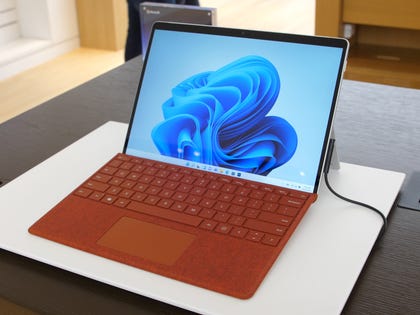
Bigger and better
$1,000 at Best Buy
-
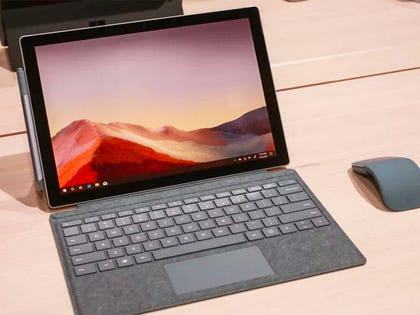
Still great for a good price
$1,070 at Walmart
Microsoft announced its latest premier two-in-one, the?Surface Pro 8, at its?Sept. 22 event?and it’s now available to buy starting at $1,100. The Surface Pro hadn’t received a full update since October 2019, when the Pro 7 was introduced. That seems like eons ago — and even then it didn’t change much from the Surface Pro 6.?
Earlier this year, Microsoft did introduce the Surface Pro 7 Plus for Business. However, it has the same design as the Pro 7 but with 11th-gen Intel processors and Windows 10 Pro. There’s also the 13-inch Surface Pro X that uses a custom Arm-based chipset from Microsoft instead of an Intel processor. With Windows 11 now available, though, this is a good time to update it inside and out, and that’s what we got.?
While the Surface Pro 7 is no longer in the lineup, you’ll still be able to buy one –?likely at a discount — until retailers sell through their stock. Microsoft is keeping the Surface Pro 7 Plus around and will have a consumer version of it with Windows 11 Home for those who want a “classic Surface Pro.”?
A larger, faster display
The?Surface Pro 8 is essentially a mashup of the Pro 7 Plus and Pro X; it’s the same-ish body of the 13-inch Pro X with the processors of the Pro 7 Plus. The Pro 8 is thicker and heavier than the Pro X but not by much. Since the Pro 7 and Pro 7 Plus are built around a 12.3-inch display, the 13-inch Pro 8 is larger than that model, too.?
Although the Surface Pro 8 display is the same size and resolution as the Pro X, the Surface Pro 8’s screen has a refresh rate that goes up to 120Hz, which should make writing and drawing on the display a smoother experience (and gaming, too). When the extra speed isn’t needed, it can drop to 60Hz to save battery life.?
Specs
| Surface Pro 8 | Surface Pro 7 Plus (2021) | Surface Pro 7 (2019) | iPad Pro (12.9-inch, 2021) | |
| Price | Starts at $1,100, £999, AU$1,649 | Starts at $900, £909, AU$1,349 | Starts at $650, £639, AU$1,149 | Starts at $999, £199, AU$1,649 |
| Optional keyboard | $180, £160, AU$260 | $129, £125, AU$200 | $129, £125, AU$200 | $329, £329, AU$549 |
| Optional stylus | $130, £120, AU$190 | $99, £60, AU$140 | $99, £60, AU$140 | $119, £119, AU$199 |
| Display | 13-inch PixelSense display (120Hz), 2,880×1,920 (267 ppi) | 12.3-inch PixelSense display, 2,736×1,824 resolution (267 ppi) | 12.3-inch PixelSense display, 2,736×1,824 resolution (267 ppi) | 12.9-inch Liquid Retina XDR True Tone with ProMotion display, 2,732×2,048 resolution (264 ppi) |
| Processor | 11th-gen Intel Core i5, i7 | 11th-gen Intel Core i3, i5, i7 | 10th-gen Intel Core i3, i5, i7 | M1 |
| RAM | 8GB / 16GB / 32GB | 8GB / 16GB / 32GB | 4GB / 8GB / 16GB | 8GB / 16GB |
| Storage | 128GB / 256GB / 512GB / 1TB | 128GB / 256GB / 512GB / 1TB | 128GB / 256GB / 512GB / 1TB | 128GB / 256GB / 512GB / 1TB / 2TB |
| SIM card support for cellular model | None | Nano-SIM, eSIM | None | Nano-SIM; eSIM; 5G support (sub-6 GHz and mmWave) |
| Wireless | 802.11ax (Wi-Fi 6), Bluetooth 5.1 | 802.11ax (Wi-Fi 6), Bluetooth 5.0 | 802.11ax (Wi-Fi 6), Bluetooth 5.0 | 802.11ax, Bluetooth 5.0 |
| Ports | USB-C (2; USB 4.0/Thunderbolt 4), Surface Connect, Surface Type Cover port, 3.5mm headphone jack | USB-C, Surface Connect, Surface Type Cover port, MicroSDXC, USB-A, 3.5mm headphone jack | USB-C, Surface Connect, Surface Type Cover port, MicroSDXC, USB-A, 3.5mm headphone jack | USB-C with Thunderbolt 4/USB 4 support |
| Cameras | Front: 5-megapixel with support for Windows Hello, rear: 10-megapixel | Front: 5-megapixel with support for Windows Hello, rear: 8-megapixel | Front: 5-megapixel with support for Windows Hello, rear: 8-megapixel | Front: 12-megapixel TrueDepth; 1080p video, rear: 12-megapixel f/1.8 wide, 10-megapixel f/2.4 ultrawide |
| OS | Windows 11 Home | Windows 10 Pro or Windows 11 Pro | Windows 10 Home | iPadOS |
| Dimensions (HWD) | 11.3 x 8.2 x 0.37 inches | 11.5 x 7.9 x 0.33 inches | 11.5 x 7.9 x 0.33 inches | 11 x 8.5 x 0.25 inches |
| Weight | 2 lb., 0.9 kg | 1.7 lb., 0.77 kg | 1.7 lb., 0.77 kg | 1.5 lb., 0.68 kg |
| Battery life | Up to 16 hours | Up to 15 hours | Up to 10.5 hours | Up to 10 hours |
Buh-bye, USB-A; hello, Thunderbolt 4
With the move to 11th-gen Intel processors, Microsoft added not one, but two Thunderbolt 4 USB-C ports. This makes it easier than ever to connect external displays directly to the Surface Pro, as well as giving you high-speed data transfers and more expansion options with a dock or hub. And even though Microsoft still uses its proprietary Surface Connector for the power adapter, you can charge the Pro 8 via the USB-C ports.?
Of course, with the addition of the USB-C ports, something had to go: There is no more good ol’ USB-A port on the Surface Pro 8. Microsoft also did away with the microSD card slot for expanding storage. The two-in-one does offer a removable SSD option, though it is a short M.2 2230 drive. Still, it’s an option down the road if you need more physical storage.
Read more:?Here’s what the Surface Duo 2 needs to succeed. Plus, check out how the specs stack up between the?Surface Duo 2 and Surface Duo, and some?cool camera tricks the Surface Duo can do.
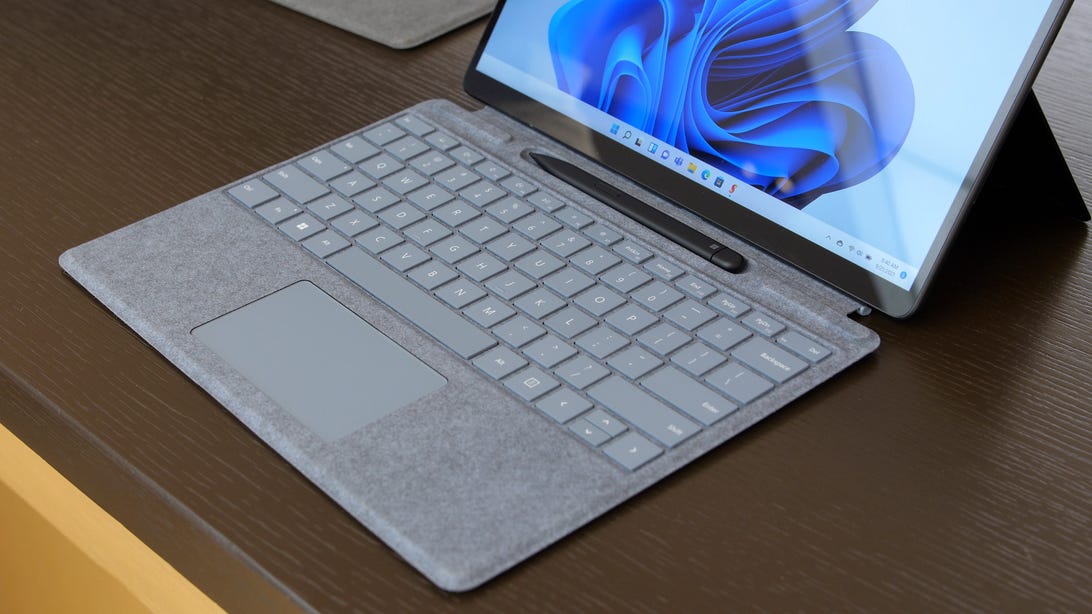
The new Slim Pen 2 magnetically stores and charges at the top of the keyboard cover.
Richard Peterson/CNETNew keyboard, new pen; neither are included
As you might expect, the increased screen size of the Surface Pro 8 means the keyboard cover from the Pro 7 won’t fit. If you’re upgrading to the Pro 8, you’ll need a new keyboard cover, too. Microsoft did develop a new one for the Pro 8 that has a spot at the top to hold and charge the new Surface Slim Pen 2.?
Like past Surface Pro models, the keyboard cover isn’t included with the Surface Pro 8. Neither is the pen. They are not cheap. The keyboard alone is $180, the pen is $130 and bundled together they’re $280. At least the kickstand is built into the body of the Pro 8 so you don’t have to buy a separate cover for that function.
A lot more time to work, create and play
While the 11th-gen Intel Core processors will certainly boost performance over the Surface Pro 7’s 10th-gen chips, it’ll also give you much better battery life. True, it helps that the Surface Pro 8 also has a larger battery pack. But, according to Microsoft’s numbers, the Pro 7 Plus, using the same size battery as the regular Pro 7, gets up to 15 hours of battery life compared to the Pro 7’s 10.5 hours. The Pro 8 will run for up to 16 hours.?
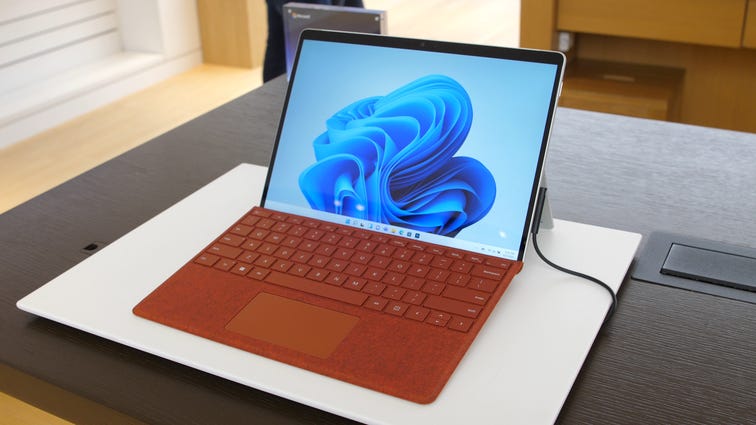
Richard Peterson/CNET
Bigger and better
Microsoft Surface Pro 8
The Surface Pro 8 has a larger, faster display, new processors to improve performance and extend battery life, Thunderbolt 4 for greater versatility and a new keyboard and pen. It is, however, still pricey, and the keyboard, which is pretty much a must-have, isn’t included. Neither is its active pen.?
Read our Surface Pro 8 review.
$1,000 at Best Buy
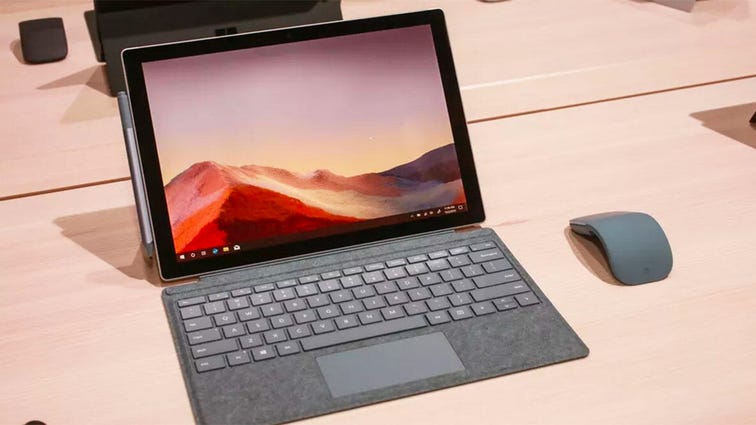
Sarah Tew/CNET
Still great for a good price
Microsoft Surface Pro 7, Surface Pro 7 Plus
Just because there’s a newer model doesn’t mean the predecessor isn’t worth considering. Microsoft immediately dropped the prices on its remaining Surface Pro 7 models. A larger display is nice, but if you’re primarily using it as a tablet, the smaller Pro 7 is a better option. Battery life and performance might not be as good as the Pro 8 but you’ll be saving money. And if you want the smaller size with the benefits of Intel’s 11th-gen processors, it looks like you’ll be able to get that with the Surface Pro 7 Plus minus the extra cost for the commercial version.
Read our Surface Pro 7 review.
$1,070 at Walmart
Read More
- Surface Pro 8 review: A familiar companion for Windows 11
- Surface Pro 7 review: A welcome visit from a familiar friend
- Best laptop 2022: The 15 laptops we recommend
- Windows 11 review: Microsoft’s subtle changes make you ask, update or wait?

